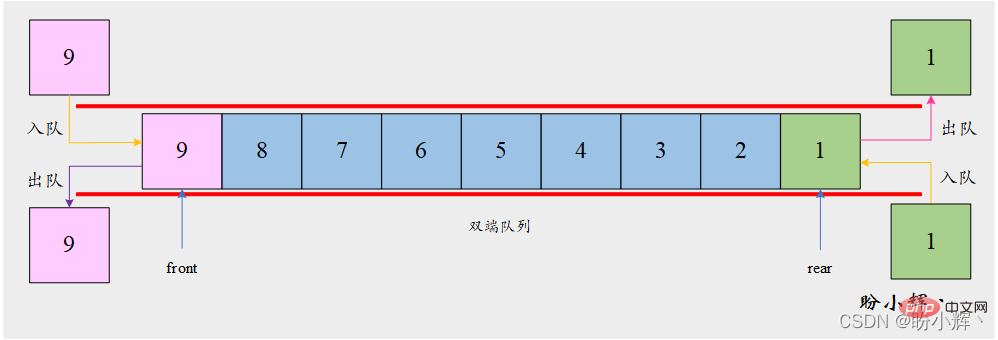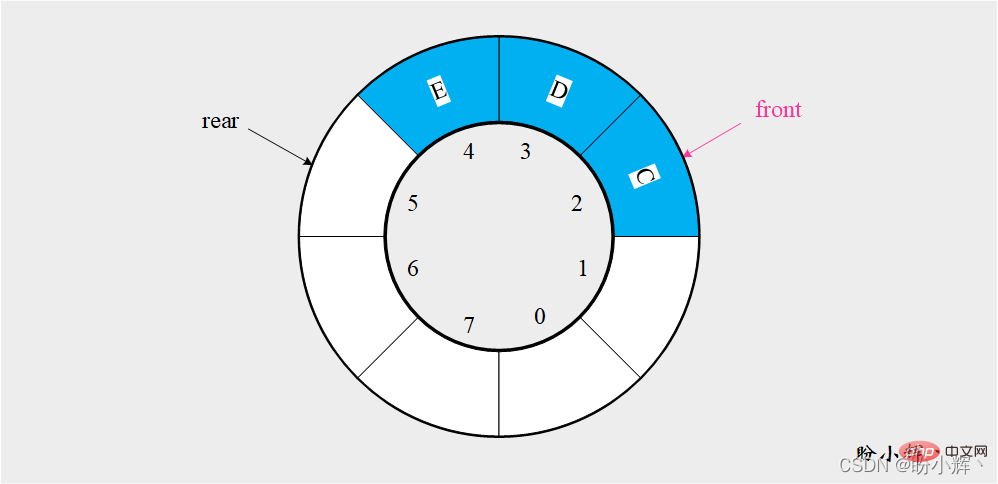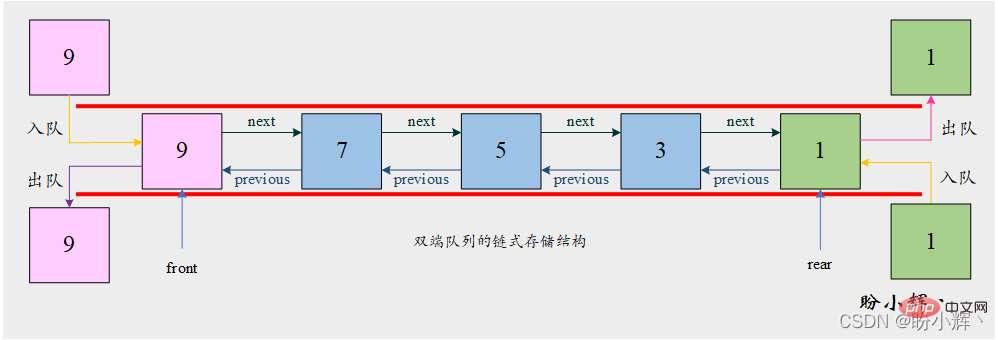 Backend Development
Backend Development
 Python Tutorial
Python Tutorial
 Python data structure and algorithm learning double-ended queue
Python data structure and algorithm learning double-ended queue
Python data structure and algorithm learning double-ended queue
This article brings you relevant knowledge about python, which mainly introduces issues related to double-ended queues, including the basic concepts of double-ended queues, the implementation of double-ended queues, and double-ended queues. The application of end queue, I hope it will be helpful to everyone.

Recommended learning: python tutorial
0. Learning objectives
Double-ended queue is another linear data structure. Although it is also a restricted linear table, unlike stacks and queues, double-ended queues have few restrictions. Its basic operations are also a subset of linear table operations, but from the perspective of data types, they are different from Linear tables are hugely different. This section will introduce the definition of a double-ended queue and its different implementations, and give some practical applications of a double-ended queue.
Through studying this section, you should master the following content:
- Basic concepts and different implementation methods of double-ended queues
- Implementation and time complexity of basic operations of double-ended queues
- Use the basic operations of double-ended queues to implement complex algorithms
1. Basic concepts of double-ended queues
1.1 Basic concepts of double-ended queues
Double-ended queue (double-end queue, deque) is also a linear list in which insertion and deletion operations are restricted to both ends of the sequence, but unlike stacks and queues The difference is that double-ended queues have few restrictions. For double-ended queues, both the tail (rear) and the head (front) allow elements to be inserted and deleted. New elements can be added to the head or tail of the queue. Likewise, existing elements can be removed from either end. In a sense, a double-ended queue can be considered a combination of a stack and a queue.

Although a double-ended queue has many features of stacks and queues, it does not require following the LIFO principles and limitations defined by these two data structures. FIFO Principle operation element.
1.2 Double-ended queue abstract data type
In addition to adding and removing elements, the double-ended queue also has auxiliary operations such as initialization, queue empty judgment, and queue length determination. . Specifically, the abstract data type of the deque is defined as follows:
Basic operations:
1. __itit__(): Initialize the double-ended queue
Create an empty deque
˜ 2. size(): Get and return the number n
of elements contained in the double-ended queue. ˜ ˜If the double-ended queue is empty, return the integer 0
˜ ˜ 3. isempty(): Determine whether it is empty. End queue
judge whether the element is stored in the double-ended queue
4. addfront(data): Add element to the head of the double-ended queue
Insert the element data into the head of the queue
5. addrear(data): Double Add elements to the end of the double-ended queue
Insert element data into the end of the queue
6. removefront(): Delete the head element of the double-ended queue
Delete and return the head element
7. removerear(): Delete The tail element of the double-ended queue
˜ ˜Delete and return the tail element
2. Implementation of the double-ended queue
Like the ordinary queue, the double-ended queue also has sequential storage and There are two storage representation methods of chain storage.
2.1 Implementation of sequential double-ended queue
Similar to the sequential queue, the sequential storage structure of the double-ended queue uses a set of storage units with consecutive addresses to store sequentially from the double-ended queue. From the elements from the head of the queue to the tail of the double-ended queue, two pointers front and rear are required to indicate the positions of the queue head element and the queue tail element respectively. When initializing an empty double-ended queue, front=rear=0, when an element enters the queue, rear increases by 1, and when an element dequeues, front increases by 1 , and in order to reuse free space, we assume that the sequential double-ended queue has a tail ring space, and the last space and the first space are regarded as continuous spaces (for specific reasons, please refer to

The same sequential double-ended queue can be of fixed length and dynamic length. When the double-ended queue is full, the fixed-length sequential double-ended queue will throw a double-ended queue full exception, and the dynamic sequential double-ended queue will throw a double-ended queue full exception. Free space will be dynamically applied for.
2.1.1 Initialization of double-ended queue
Initialization of sequential double-ended queue requires 4 pieces of information: deque List is used to store data elements , max_size is used to store the maximum length of the queue list, and front and rear are used to record the head and tail elements of the queue respectively. index of:
class Deque: def __init__(self, max_size=6): self.max_size = max_size self.deque = [None] * self.max_size self.front = 0 self.rear = 0
2.1.2 Find the length of the double-ended queue
Since front and rear are used to record the head element and tail element respectively The index of the element, so we can easily calculate the length of the double-ended queue; at the same time, we need to consider that the double-ended queue is a circular queue, front may be larger than rear, and cannot be passed directly rear-front, we need to use formula calculation to solve this problem:
Python The implementation is as follows:
def size(self): return (self.rear-self.front+self.max_size) % self.max_size
2.1.3 Judgment Double-ended queue is empty
You can easily determine whether the double-ended queue is empty based on the values of front and rear:
def isempty(self): return self.rear==self.front
2.1.4 Determining that the double-ended queue is full
According to the values of front and rear, it is easy to determine whether there is free space in the double-ended queue:
def isfull(self): return ((self.rear+1) % self.max_size == self.front)
2.1.5 Add elements to the head and tail of the double-ended queue
When adding elements, you need to first determine whether there is free space in the double-ended queue, and then determine the size of the double-ended queue according to the Long sequential deque or dynamic sequential deque, the operation of adding elements is slightly different:
[Add element operation of fixed-length sequential deque] If the queue is full, an exception is thrown:
# 注意队头和队尾修改索引的添加元素的不同顺序
def addrear(self, data):
if not self.isfull():
self.deque[self.rear] = data
self.rear = (self.rear+1) % self.max_size else:
raise IndexError("Full Deque Exception")
def addfront(self, data):
if self.isfull():
self.resize()
if self.isempty():
# 当Python data structure and algorithm learning double-ended queue
self.deque[self.rear] = data
self.rear = (self.rear+1) % self.max_size else:
self.front = (self.front - 1 + self.max_size) % self.max_size
self.deque[self.front] = data[Add element operation of dynamic sequence double-ended queue] If the double-ended queue is full, apply for new space first, and then perform the add operation:
def resize(self): new_size = 2 * self.max_size new_deque = [None] * new_size d = new_size - self.max_size for i in range(self.max_size): new_deque[(self.front+i+d) % new_size] = self.deque[(self.front+i) % self.max_size] self.deque = new_deque self.front = (self.front+d) % new_size self.max_size = new_size # 注意队头和队尾修改索引的添加元素的不同顺序 def addrear(self, data): if self.isfull(): self.resize() self.deque[self.rear] = data self.rear = (self.rear+1) % self.max_size def addfront(self, data): if self.isfull(): self.resize() self.front = (self.front - 1 + self.max_size) % self.max_size self.deque[self.front] = data
With dynamic sequence Similar to queues, we also need to consider the index after copying, otherwise there may be unusable free space:

The time complexity of adding elements is O(1). Although when the dynamic sequential double-ended queue is full, the elements in the original double-ended queue need to be copied to the new double-ended queue first, and then new elements are added. However, refer to the introduction of the sequential table append operation in "Sequence Table and Its Operation Implementation", Due to the total time of n add element operationsT(n) and O(n) is directly proportional, so its amortized time complexity can be consideredO(1).
2.1.6 Delete the element at the head or tail of the queue
If the double-ended queue is not empty, delete and return the element at the specified end:
# 注意队头和队尾修改索引的删除元素的不同顺序
def removefront(self):
if not self.isempty():
result = self.deque[self.front]
self.front = (self.front+1) % self.max_size return result else:
raise IndexError("Empty Deque Exception")
def removerear(self):
if not self.isempty():
self.rear = (self.rear - 1 + self.max_size) % self.max_size
result = self.deque[self.rear]
return result else:
raise IndexError("Empty Deque Exception")2.2 Implementation of chained double-ended queue
Another storage representation of a double-ended queue is to use a chained storage structure, so it is also often called a chained double-ended queue, where## The #addfront operation and the addrear operation are implemented by inserting elements at the head and tail of the linked list respectively, while the removefront operation and the removerear operation are respectively This is achieved by deleting nodes from the head and tail. In order to reduce the time complexity of deleting nodes at the tail, a double-ended queue is implemented based on a doubly linked list.

class Node: def __init__(self, data=None): self.data = data self.next = None def __str__(self): return str(self.data)
front and the tail pointer rear both point to None, and initialize the length of the double-ended queue:
class Deque: def __init__(self): self.front = None self.rear = None self.num = 0
num to find the length of the double-ended queue The length of The length of the queue can easily determine whether it is an empty double-ended queue:
def size(self): return self.num
2.2.5 Adding elements When adding elements to a double-ended queue, you can insert new elements at the end or head of the queue. element, so you need to modify the rear
andfront
pointers, and also modify the node'snext
andprevious pointers; if you add an element The former double-ended queue is empty and needs to be processed accordingly:
def addrear(self, data): node = Node(data) # 如果添加元素前Python data structure and algorithm learning double-ended queue为空,则添加结点时,需要将front指针也指向该结点 if self.front is None: self.rear = node self.front = node else: node.previous = self.rear self.rear.next = node self.rear = node self.num += 1 def addfront(self, data): node = Node(data) # 如果添加元素前Python data structure and algorithm learning double-ended queue为空,则添加结点时,需要将rear指针也指向该结点 if self.rear is None: self.front = node self.rear = node else: node.next = self.front self.front.previous = node self.front = node self.num += 1
2.2.6 删除元素
若Python data structure and algorithm learning double-ended queue不空,可以从删除队头或队尾元素并返回,删除操作需要更新队头指针 front 以及尾指针 rear,同时也要修改结点的 next 和 previous 指针,若出队元素尾队中最后一个结点,还需要进行相应处理:
def removefront(self):
if self.isempty():
raise IndexError("Empty Queue Exception")
result = self.front.data
self.front = self.front.next
self.num -= 1
if self.isempty():
self.rear = self.front else:
# 若删除操作完成后,Python data structure and algorithm learning double-ended queue不为空,将 front 指针的前驱指针指向 None
self.front.previous = None
return result
def removerear(self):
if self.isempty():
raise IndexError("Empty Queue Exception")
result = self.rear.data
self.rear = self.rear.previous
self.num -= 1
if self.isempty():
self.front = self.rear else:
# 若删除操作完成后,Python data structure and algorithm learning double-ended queue不为空,将 rear 指针的后继指针指向 None
self.rear.next = None
return result2.3 Python data structure and algorithm learning double-ended queue的不同实现对比
Python data structure and algorithm learning double-ended queue的不同实现对比与栈的不同实现类似,可以参考《栈及其操作实现》。
3. Python data structure and algorithm learning double-ended queue应用
接下来,我们首先测试上述实现的Python data structure and algorithm learning double-ended queue,以验证操作的有效性,然后利用实现的基本操作来解决实际算法问题。
3.1 顺序Python data structure and algorithm learning double-ended queue的应用
首先初始化一个顺序Python data structure and algorithm learning double-ended queue deque,然后测试相关操作:
# 初始化一个最大长度为5的Python data structure and algorithm learning double-ended queuedq = Deque(5)print('Python data structure and algorithm learning double-ended queue空?', dq.isempty())for i in range(3):
print('队头添加元素:', 2*i)
dq.addfront(2*i)
print('队尾添加元素:', 2*i+1)
dq.addrear(2*i+1)print('Python data structure and algorithm learning double-ended queue长度为:', dq.size())for i in range(3):
print('队尾删除元素:', dq.removerear())
print('队头删除元素:', dq.removefront())print('Python data structure and algorithm learning double-ended queue长度为:', dq.size())测试程序输出结果如下:
Python data structure and algorithm learning double-ended queue空? True队头添加元素: 0队尾添加元素: 1队头添加元素: 2队尾添加元素: 3队头添加元素: 4队尾添加元素: 5Python data structure and algorithm learning double-ended queue长度为: 6队尾删除元素: 5队头删除元素: 4队尾删除元素: 3队头删除元素: 2队尾删除元素: 1队头删除元素: 0Python data structure and algorithm learning double-ended queue长度为: 0
3.2 链Python data structure and algorithm learning double-ended queue的应用
首先初始化一个链Python data structure and algorithm learning double-ended queue queue,然后测试相关操作:
# 初始化新队列dq = Deque()print('Python data structure and algorithm learning double-ended queue空?', dq.isempty())for i in range(3):
print('队头添加元素:', i)
dq.addfront(2*i)
print('队尾添加元素:', i+3)
dq.addrear(2*i+1)print('Python data structure and algorithm learning double-ended queue长度为:', dq.size())for i in range(3):
print('队尾删除元素:', dq.removerear())
print('队头删除元素:', dq.removefront())print('Python data structure and algorithm learning double-ended queue长度为:', dq.size())测试程序输出结果如下:
Python data structure and algorithm learning double-ended queue空? True队头添加元素: 0队尾添加元素: 3队头添加元素: 1队尾添加元素: 4队头添加元素: 2队尾添加元素: 5Python data structure and algorithm learning double-ended queue长度为: 6队尾删除元素: 5队头删除元素: 4队尾删除元素: 3队头删除元素: 2队尾删除元素: 1队头删除元素: 0Python data structure and algorithm learning double-ended queue长度为: 0
3.3 利用Python data structure and algorithm learning double-ended queue基本操作实现复杂算法
[1] 给定一字符串 string (如:abamaba),检查其是否为回文。
使用Python data structure and algorithm learning double-ended queue可以快速检查一字符串是否为回文序列,只需要将字符串中字符依次入队,然后从Python data structure and algorithm learning double-ended queue两端依次弹出元素,对比它们是否相等:
def ispalindrome(string): deque = Deque() for ch in string: deque.addfront(ch) flag = True while deque.size() > 1 and flag: ch1 = deque.removefront() ch2 = deque.removerear() if ch1 != ch2: flag = False return flag
验证算法有效性:
print('abcba是否为回文序列:', ispalindrome('abcba'))print('charaahc是否为回文序列:', ispalindrome('charaahc'))结果输出如下:
abcba是否为回文序列: True charaahc是否为回文序列: False
推荐学习:python教程
The above is the detailed content of Python data structure and algorithm learning double-ended queue. For more information, please follow other related articles on the PHP Chinese website!

Hot AI Tools

Undresser.AI Undress
AI-powered app for creating realistic nude photos

AI Clothes Remover
Online AI tool for removing clothes from photos.

Undress AI Tool
Undress images for free

Clothoff.io
AI clothes remover

Video Face Swap
Swap faces in any video effortlessly with our completely free AI face swap tool!

Hot Article

Hot Tools

Notepad++7.3.1
Easy-to-use and free code editor

SublimeText3 Chinese version
Chinese version, very easy to use

Zend Studio 13.0.1
Powerful PHP integrated development environment

Dreamweaver CS6
Visual web development tools

SublimeText3 Mac version
God-level code editing software (SublimeText3)

Hot Topics
 1386
1386
 52
52
 Can visual studio code be used in python
Apr 15, 2025 pm 08:18 PM
Can visual studio code be used in python
Apr 15, 2025 pm 08:18 PM
VS Code can be used to write Python and provides many features that make it an ideal tool for developing Python applications. It allows users to: install Python extensions to get functions such as code completion, syntax highlighting, and debugging. Use the debugger to track code step by step, find and fix errors. Integrate Git for version control. Use code formatting tools to maintain code consistency. Use the Linting tool to spot potential problems ahead of time.
 How to run programs in terminal vscode
Apr 15, 2025 pm 06:42 PM
How to run programs in terminal vscode
Apr 15, 2025 pm 06:42 PM
In VS Code, you can run the program in the terminal through the following steps: Prepare the code and open the integrated terminal to ensure that the code directory is consistent with the terminal working directory. Select the run command according to the programming language (such as Python's python your_file_name.py) to check whether it runs successfully and resolve errors. Use the debugger to improve debugging efficiency.
 Can vs code run in Windows 8
Apr 15, 2025 pm 07:24 PM
Can vs code run in Windows 8
Apr 15, 2025 pm 07:24 PM
VS Code can run on Windows 8, but the experience may not be great. First make sure the system has been updated to the latest patch, then download the VS Code installation package that matches the system architecture and install it as prompted. After installation, be aware that some extensions may be incompatible with Windows 8 and need to look for alternative extensions or use newer Windows systems in a virtual machine. Install the necessary extensions to check whether they work properly. Although VS Code is feasible on Windows 8, it is recommended to upgrade to a newer Windows system for a better development experience and security.
 Is the vscode extension malicious?
Apr 15, 2025 pm 07:57 PM
Is the vscode extension malicious?
Apr 15, 2025 pm 07:57 PM
VS Code extensions pose malicious risks, such as hiding malicious code, exploiting vulnerabilities, and masturbating as legitimate extensions. Methods to identify malicious extensions include: checking publishers, reading comments, checking code, and installing with caution. Security measures also include: security awareness, good habits, regular updates and antivirus software.
 What is vscode What is vscode for?
Apr 15, 2025 pm 06:45 PM
What is vscode What is vscode for?
Apr 15, 2025 pm 06:45 PM
VS Code is the full name Visual Studio Code, which is a free and open source cross-platform code editor and development environment developed by Microsoft. It supports a wide range of programming languages and provides syntax highlighting, code automatic completion, code snippets and smart prompts to improve development efficiency. Through a rich extension ecosystem, users can add extensions to specific needs and languages, such as debuggers, code formatting tools, and Git integrations. VS Code also includes an intuitive debugger that helps quickly find and resolve bugs in your code.
 Python: Automation, Scripting, and Task Management
Apr 16, 2025 am 12:14 AM
Python: Automation, Scripting, and Task Management
Apr 16, 2025 am 12:14 AM
Python excels in automation, scripting, and task management. 1) Automation: File backup is realized through standard libraries such as os and shutil. 2) Script writing: Use the psutil library to monitor system resources. 3) Task management: Use the schedule library to schedule tasks. Python's ease of use and rich library support makes it the preferred tool in these areas.
 Can visual studio code run python
Apr 15, 2025 pm 08:00 PM
Can visual studio code run python
Apr 15, 2025 pm 08:00 PM
VS Code not only can run Python, but also provides powerful functions, including: automatically identifying Python files after installing Python extensions, providing functions such as code completion, syntax highlighting, and debugging. Relying on the installed Python environment, extensions act as bridge connection editing and Python environment. The debugging functions include setting breakpoints, step-by-step debugging, viewing variable values, and improving debugging efficiency. The integrated terminal supports running complex commands such as unit testing and package management. Supports extended configuration and enhances features such as code formatting, analysis and version control.
 Can vs code run python
Apr 15, 2025 pm 08:21 PM
Can vs code run python
Apr 15, 2025 pm 08:21 PM
Yes, VS Code can run Python code. To run Python efficiently in VS Code, complete the following steps: Install the Python interpreter and configure environment variables. Install the Python extension in VS Code. Run Python code in VS Code's terminal via the command line. Use VS Code's debugging capabilities and code formatting to improve development efficiency. Adopt good programming habits and use performance analysis tools to optimize code performance.



